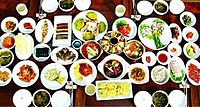
Photo from wikipedia
BACKGROUND As South Korea has enjoyed rapid economic development, Koreans' diet, particularly consumption of fast food (FF) and sugar-sweetened beverages (SSBs), has changed. OBJECTIVE To examine time trends in FF… Click to show full abstract
BACKGROUND As South Korea has enjoyed rapid economic development, Koreans' diet, particularly consumption of fast food (FF) and sugar-sweetened beverages (SSBs), has changed. OBJECTIVE To examine time trends in FF and SSB consumption and their associations with social environmental status (SEnS) in South Korea. DESIGN Korean National Health and Nutrition Examination Surveys (KNHANES) were a series of population-based cross-sectional surveys. PARTICIPANTS Data from the KNHANES conducted in 1998, 2001, 2005, and 2007-2009 for 49,826 Koreans aged ≥1 year were used. MAIN OUTCOME MEASURES Consumption of FF and SSBs were assessed by a 24-hour recall. We defined two FF categories (Western-style and Korean-style) and one SSB category. Sex, age, household income, and residence regions were investigated. STATISTICAL ANALYSES PERFORMED The primary sampling units, strata, and sampling weights were taken into account using SAS survey-related procedures. Logistic regression models were used to test associations between SEnS and FF consumption. RESULTS Over an 11-year period, the proportion of participants' who consumed Western FF and SSBs on the surveyed day doubled (P<0.05). Per capita energy contribution from Western FF also increased in adults, men, and low-income groups. SSB consumption doubled (per capita: 32 to 82 kcal/day, only consumers: 123 to 166 kcal/day), but consumption of Korean-style FF decreased (P<0.05). Compared with the low-income rural resident group, the high-income urban resident group was much more likely to consume Western FF (OR=26.7[3.7, 193.4]) and SSBs (odds ratio [OR]=3.1 [2.4, 4.1]) in 1998. However, in recent years, the patterns changed; the high-income urban resident group was more likely to consume Korean-style FF (OR=2.0[1.3, 2.9]) and SSBs (OR=1.7[1.3, 2.1]). CONCLUSIONS In South Korea, people who reported consuming Western FF and SSBs on the surveyed day almost doubled during 1998-2009, whereas those who consumed Korean FF decreased. SEnS was related to FF and SSB consumption.
Journal Title: Journal of the Academy of Nutrition and Dietetics
Year Published: 2018
Link to full text (if available)
Share on Social Media: Sign Up to like & get
recommendations!